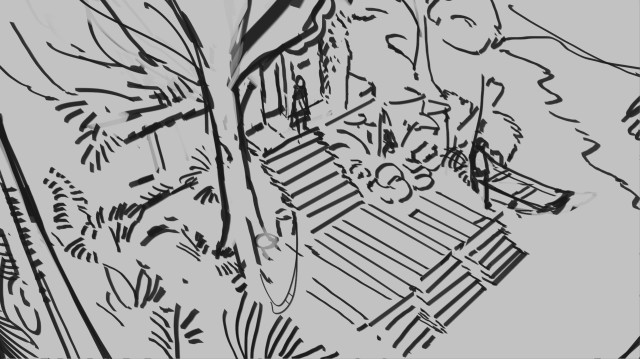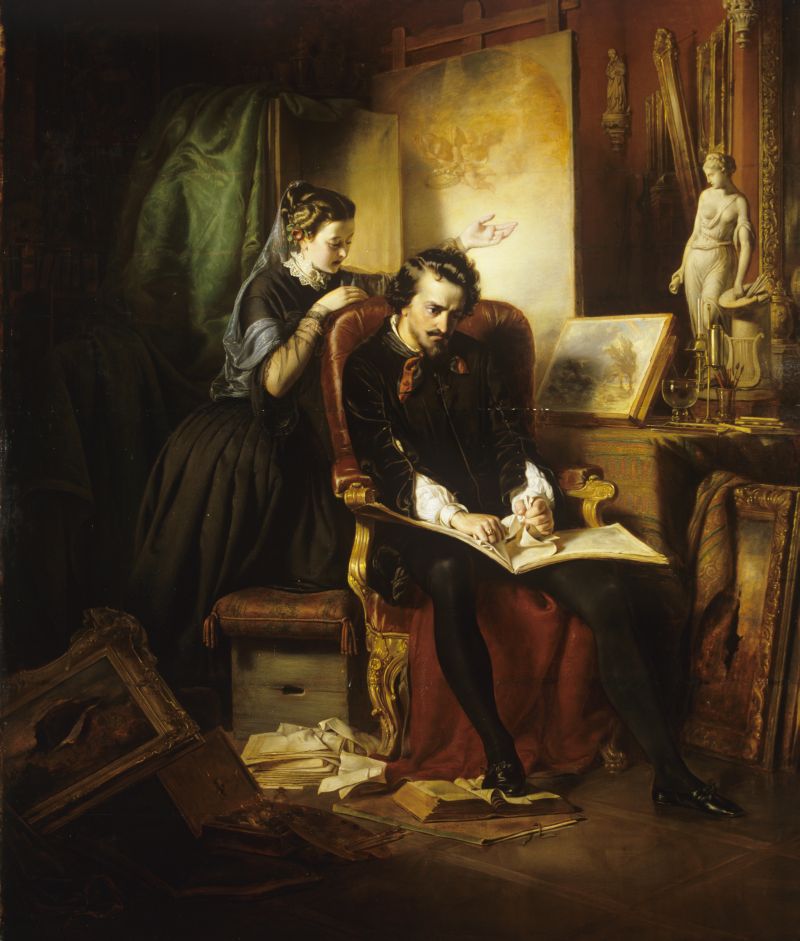I’ve been in the industry for a little while now. One of the concepts that appears to be ubiquitously linked to the notion of professional writing is that of the dreaded writer’s block. Aren’t we all too familiar with the picture of a spectacled (wo)man in a study, seated in front of a computer screen, gazing out the window while looking for something to inspire them?

I found a way to save myself from this affliction. In fact, it’s a different way to view the craft that allows me to avoid halting my writing progress altogether. A little secret perhaps, that I want to share with you. Are you ready?
…
You’re picturing writer’s block wrong.
The writer as a painter
People usually compare writing to painting. You start out with a blank canvas: the untouched paper. The painter or writer then fills that canvas with either brushstrokes or words. The end result? The immaculate slate has been transformed into a competent display of skill, courtesy of the brilliant creator’s vision.

But before we get to that result, the first brushstroke – the first word – must be placed on that canvas. Enter: anxiety.
After all, what if I mess up? What is the first sentence my audience should read? Should I start in media res, or do I want to establish the state of the world first? What is the name of my protagonist anyway?
And this is where many writers get stuck. “No inspiration!”, they will cry. Or they mutter something about not being in the mood. “Today is simply a bad day, tomorrow will be better.” Or the often heard: “I will start on another project first, and then proper material for this one will come to me eventually.”
Poppycock, I say.
The writer as a sculptor
We have a Dutch saying: Schrijven is schrappen. This would translate to ‘writing is scrapping’, but you’d miss out on all the hard ‘g’s and rolling ‘r’s. The saying tells us that good writing is efficient, pithy, concise. Trim as much as you can, so that all that is left is the bare essential required to state your message. This is what we define as ‘good writing’. But to cut text is to have text in the first place. And any rough body of text will do.
So, I introduce a new concept of the writer’s block. I reject the comparison with the visual artist. Instead, I move to use the sculptor – more specifically: a stone carver – as a metaphor. I think that whatever first version you write is a block of marble at which you may then chip away.

You need to start with a block of text: it doesn’t matter what the quality is. Everything is subject to change – all the time – and everything is a draft until you submit to final. That last bit is just a healthy writing ethos and all but common sense, but it does help lift the pressure off your performance. If you accept that everything you write will likely be deleted or revised later anyway, you won’t feel so bad about writing flawed passages.
Building a Block
Of course, there is still the matter of actually getting your hands on that block of text. There’s several approaches you can adopt. One of these is Free Writing: just keep writing for a specified amount of time. There is no stopping to think what to write next, and revision before the timer ends is prohibited. Your result is at least 50% rubbish, and the parts that you could salvage surely riddled with errors when it’s not altogether incoherent. But that’s not the point of the exercise.
Another approach is the so-called Snowflake method. You start with a basic idea of what you want to write, then you add some outlines to that, then you add more details to that, then you add additional copy to that… and so on, until you have a body of text you’re satisfied with. This allows you to add passages at different locations in your text, instead of writing a string of words from beginning to end.

Either approach – and be sure to find the approach that suits you best – will provide you with a block of text that you can then reshape into whatever you need it to be. You can begin carving. There’s no more anxiety while staring at the white sheet of paper. No more questioning what the first line should be. You can cut at it, create room and then fill in the blanks. You can start the actual process of writing. Schrijven is schrappen.
I hardly use Free Writing myself, because I always end up with some sort of a diary entry, just writing down what occupies my mind. I sometimes use the Snowflake method, especially when writing for larger projects. Most often though, I force myself to write something down. Whether constructing a plot, writing dialogue, barks – whatever: I write something, anything down. Because I know I can improve on that. And the process of improving is so much easier!
Some thoughts on NaNoWriMo
When I taught at a University of Applied Sciences, some of my students introduced me to the NaNoWriMo (National Novel Writing Month) phenomenon. The initiative challenges you to write 50,000 words in the month of November, or 30 days. The promise? That the challenge yields you a novel.
What I asked my students to reflect on, was that the challenge of 50,000 words in 30 days would NOT yield you a novel at the end. At best you could have a solid block of textual marble to help you start off your carving. And that’s great! Who knows what masterpiece lies within? But thinking that writing 50,000 words automatically transform pages after pages of text into a novel, that’s a dangerous illusion.
It is my humble opinion that the NaNoWriMo process is a variation of Free Writing; the word count has simply replaced the timer (and a deadline was added). So, feel free to use this as a block-o’-text generator! Just understand the limitations of the process.
Sculpting this article
In my process of writing this article, I’ve gone over the text a few times. First, just to write down the main points I want to make, then I add the arguments that connect those points. This results in a rough draft. Then, I rewrite, delete obsolete words, restructure, rethink my choice of words and implement synonyms, scrap a few paragraphs entirely, consider what figures of speech to use…

The result is this article you’ve now almost finished reading. It’s not perfect. Primarily because there is sufficient room for me to grow as a writer (thankfully). Secondly because it’s my (academic) philosophy that a text can always be improved. My text is never finished. I can always tinker more. But the deadline comes, either sooner or later. When my text communicates what I need it to, I can label it ‘done’.
Discipline vs Inspiration
I won’t deny that I can get into a flow when writing for a project, and that it’s hard to control when this flow may occur. In that sense, mood or whatever you want to call it can help you writer better and/or faster. But I refuse to believe in what’s commonly referred to as ‘writer’s block’. I will even go as far as to state that I expect of any professional writer worth their salt to circumvent such a creative block. It’s a matter of discipline rather than inspiration. The romantic image of the writer waiting to be touched by their muse doesn’t compute in the game industry.

There are many people who love the idea of writing, but never actually succeed in composing any decent body of text. They tell me they never seem able to take that first step properly. I say: scrap ‘properly’ from that sentence. Just take the first step. Write anything down. Deciding if it’s any good comes later.
Once your discipline yields you your block of text, your pen turns into a chisel, and your mind into a hammer. Carve away! Scrap your text! What emerges is your artwork.
So there’s my secret! My method of never running out of steam and always deliver on time. Please join me in craving (not a typo) the Writer’s Block. Celebrate it! The sooner you start writing, the sooner you can start the revision. You’ll need that second step if you want your writing to become great or even excellent.
If you’re using a different method with similar results: I would love to hear it!
If you have further questions concerning my approach: please reach out!
For everyone else: keep on writing!
I surely will!

Picture in the banner: József Borsos – The Dissatisfied Painter


A very insightful post, and it helped me get over my very own block! I never knew I’d been using the snowflake method. Haven’t had great results with freewriting though, because if I don’t get a sentence just right, it irks me enough that I can’t move on with the rest of the story.
Perhaps for your next post, you could highlight the things writers can do when every piece of their work seems like trash?
Thank you for the compliment, Stuart! I’m glad you found it useful. I fully empathise with your Free Writing experiences, but I understand it’s a great help for a lot of writers.
I love your idea for a follow-up post! I’ll add it to my list of topics still to cover. I appreciate the input!
Very helpful! All writers experience writer’s block moments when one simply struggles to put ideas into words.
Please read my blog on How to Beat Writer’s Block